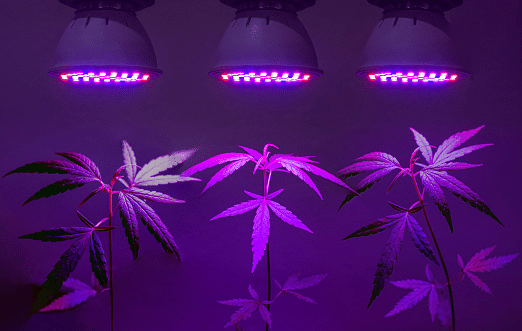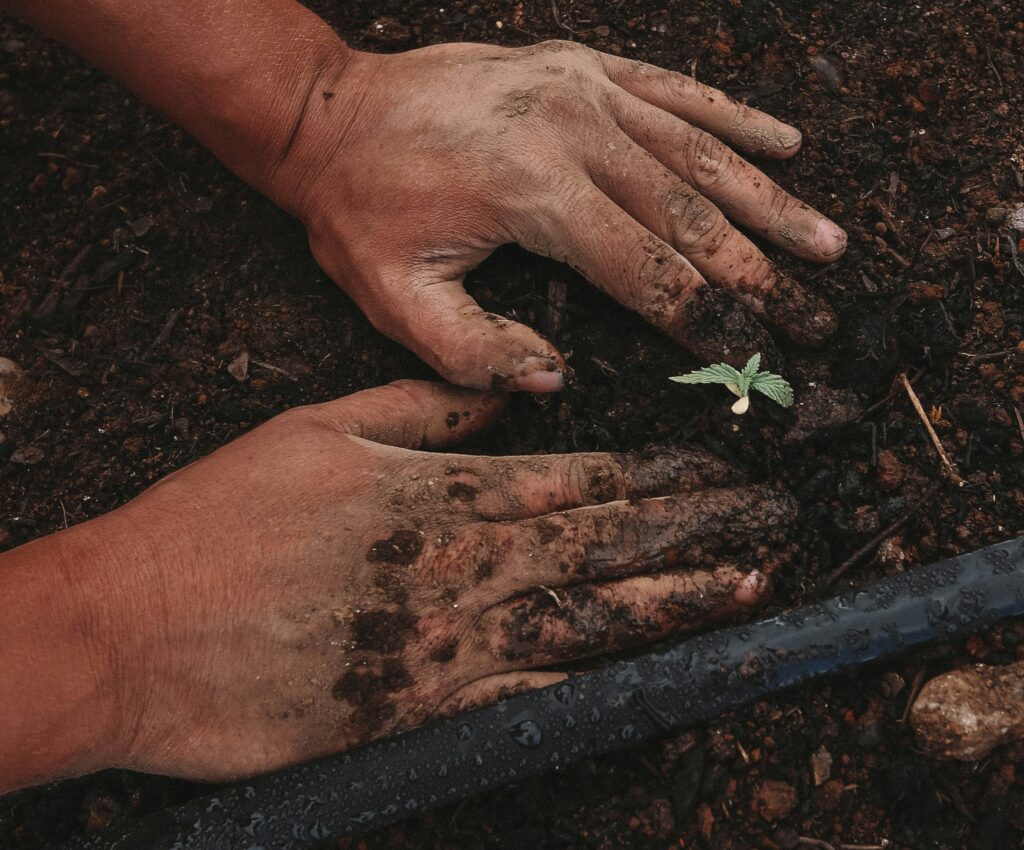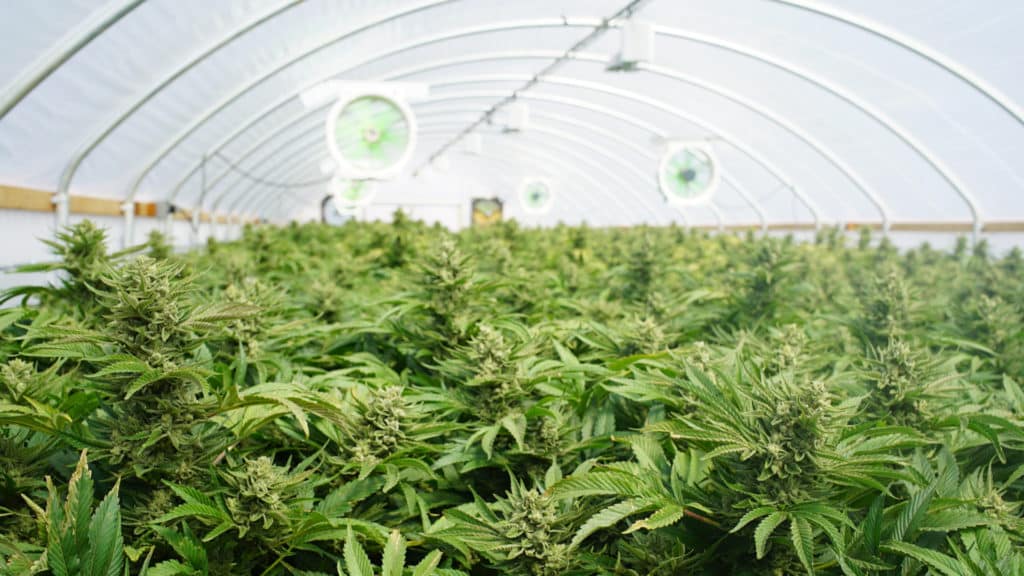When growing marijuana either recreationally or medically, it is important to know which equipment and methods are going to give you the most bang for your buck. Your choice of seeds, soil, and lights will all severely affect the outcomes of your cannabis creation. While seeds and soil are important, your cannabis plants require light for the photosynthetic process, and as such, lighting can make or break a cannabis grow.
Light Measurements
It is important to understand that nanometres (nm) are a measurement of one specific wavelength of light (one specific color is one billionth of a meter on the scale), while Kelvin (K) measures the “color temperature” of a light and offers an indication to the peak nanometers (nm) within the spectrum that each light offers. More on that later…
Why Do Light Measurements Matter?
Marijuana plants flourish in a light spectrum between 420nm and 750nm. This range is ideal for the plants, as this kind of light falls in the P.A.R. (Photosynthetically Active Radiation) spectral range of solar radiation which is from 400 to 700 nanometers. This is the range of light that photosynthetic organisms, like our marijuana plants, use for photosynthesis.
Some artificial light outside of this range can be used to mimic seasons of growing like spring or autumn, which enable plants to generate significant growth. Has science gone too far!?
As with visible light, each of the spectral colors has its own wavelength band: 380nm – 430nm = violet, 430nm – 500nm = blue, 500nm – 520nm = cyan, 520nm – 560nm = green, 560nm – 590nm = yellow, 590nm – 625nm = orange, and 625nm – 780nm = red. These ranges are important because they easily quantify the kind of light you’ll need to “feed” your marijuana plants during varying growth stages.
For plants, the green and yellow ranges of the spectrum are slightly less useful because the light in these wavelengths is reflected by leaves. This is why we perceive most plants as green! Almost all plants can use light across the entire visible range for photosynthesis, but some wavelengths are more useful during specific stages of a plant’s growth. The blue, orange, and red ranges each have different impacts on plant growth.
Light with high proportions in the blue range (420 to 550nm) can enhance vegetative growth, while the orange and red ranges (550 to 750nm) strongly influence flowering and fruiting. This can actually be observed in nature! In the spring and early summer, plants are bursting into growth because the light in the sky is more blue. In the shortening days of late summer and early autumn, the light is typically warmer due to the greater proportions of orange and red.
I know I have been berating you with science facts, but stay with me, it will be to your benefit. The noteworthy takeaway here is that marijuana plants need light from specific parts of the spectrum with specific amounts of light intensity to create proper and speedy bud production.
What Kind of Grow Lights Are There?
There is an endless array of lights! For our purposes, we will only focus on those most effective for growing marijuana. First, you have HID (High Intensity Discharge) lights like HPS (High Pressure Sodium) and MH (Metal Halide) lights. There are also fluorescent and compact fluorescent (CFL) grow lights, as well as incandescent lights. The other important category you’ve likely heard of due to its recent surge in popularity is LED (Light Emitting Diode) lights.
HPS lights produce light in the spectrum between 540 and 700 nm, which typically means yellow, amber, and red light colors. This is the best range for flowering marijuana.
MH lights create light between 350 and 550 nm, which typically means blue, green, and yellow light colors. MH lights are great for the vegetative growth stage, however they can negatively impact the flowering stage.
Fluorescent and CFL grow lights are perfect for germination and seedlings. They are very popular for growing low-light plants like herbs and African violets. Fluorescent lights have low intensity and need to be placed within 8” (up to 15” for shade loving plants) of the plants to be effective. They are generally a poor light source for flowering primarily because of their low lumen output.
Incandescent lights are also excellent for starting germination and seedlings, but they should be avoided for the vegetative and flowering growth stages because of their low lumen output and limited range. In recent years, LEDs have overtaken CFLs even in small cultivation areas due to the vast improvement in the cost of powerful LEDs.
LED grow lights are all the rage today. These bad boys have the capability to produce a mixture of light spectrums! It is best to find one that can easily simulate sunshine, which is basically white light. The best LEDs are full spectrum which cover PAR with some blues, some reds, and most importantly, a very stable white.
It’s easy to see that these LEDs are optimal since they cover the full growth spectrum between 420 and 750 nm. With this wide range, these lights can be used for growing marijuana from tiny seed to giant, glorious bud.
Which is Better HID or Full Spectrum LED Grow Lights?
Making a choice between traditional HID grow lights and full spectrum LED grow lights was once a difficult decision. This is because the LED market contained a lot of dubious traders with websites full of false or misleading claims.
These days, there are some solid performing LEDs preferred by numerous expert cultivators. LEDs save money on electricity, produce better results, reduce fire hazards, and have easily fixable heat issues and bulb replacements. To help you make a more informed decision, we’ll review the pros and cons of each grow light, and guide you through the science behind the manufacturer’s specifications.
HID lighting, HPS and MH
Although high quality LEDs are a better bet as they save you money in the long term and eliminate heat issues, they cost much more to set up compared to HPS lighting. If you have plans starting a small grow at home, then a cheap HID (HPS/MH) setup might better suit your needs.
MH bulbs produce an abundance of light in the blue spectrum, created by an electric arc through the high pressure gaseous mixture of the metal halides, bromine and iodine, and argon, xenon, and mercury. The blue spectrum promotes plant growth in general and is excellent for green leafy growth specifically. Blue spectrum is also helpful for keeping plants compact.
HPS bulbs emit an orange-red glow and are deficient in the blue spectrum. This band of light triggers hormones in the plant to increase the flower production in the plant. These are one of the best lights available for secondary or supplemental lighting and should be used in conjunction with natural sunlight or MHs. HPS orange-red lights are typically recommended for greenhouse growing.
Other than LEDs, we feel HIDs are one of the best options to use as a primary light source for vegetation. That is, of course, if little or no natural sunlight is available. Depending on the brand, you may lack important amber and red light that is most beneficial for flowering.
MH and HPS lamps have been around for a long time, and over the years there have been slow but steady improvements in bulb life and light output. However, they do have some drawbacks.
What Are the Drawbacks of HPS and MH Grow Lights?
First and foremost, HID bulbs get VERY hot. HID lamps inefficiently turn electricity into light, with a great deal wasted producing unwanted heat. Generally with HID lights, you’ll need to install cooling fans or a ventilation system in your grow room. If the grow room is large enough, air conditioning will be necessary to keep plants from burning alive. You also need to be wary of positioning lights too close to the plants, especially in the early stages of growth when plants are vulnerable and sensitive to heat.
Due to the intense heat emitted from these lights, HID fixtures need to be hung high above the plants. Smaller wattage systems (100W or 250W) should be hung about 2 to 3 feet from the top of the plants, medium wattage systems (400W or 600W) around 4 feet, and high wattage systems (1000 W+) at least 4 to 6 feet.
MH and HPS bulbs are notorious for progressive deterioration with use. These bulbs need to be replaced every 18 months to two years, instead of using them until they burn out. Most cultivators replace these bulbs every 1-2 grow cycles, meaning 2-4 times a year.
The spectral range of MH and HPS lamps is limited, so you need more than one light to provide ideal conditions for both vegetative growth and flowering. Dual spectrum lights, with an MH and an HPS lamp in the same fitting, are a poor compromise for your plants, but they’ll work. MH lamps produce a high proportion of light in the blue spectrum, which promotes strong vegetative growth. HPS lamps are heavy at the red end of the spectrum but lacking in blue light, which makes them a good fit for the flowering stage.
Operational costs and high energy consumption are the biggest drawbacks of these bulbs as substantial energy is used to power the electromagnetic ballasts. However, competent cultivators can be reasonably assured of good yields with these lights, as they were the standard for home and commercial use for decades.
Full spectrum LED
LEDs were first introduced into electronics in 1962 and have steadily improved in the subsequent 50+ years. They are now commonplace in vehicle headlights, traffic lights, and hydroponic growing. They’ve also become the fan favorite for plant cultivation, regardless of the operational size.
LEDs are so efficient they use up to 60% less power than an equivalent HID. This is because they create pure light instead of wasting electricity on heat! As the name suggests, full spectrum LEDs can provide the appropriate light spectrum for both vegetative growth and for flowering. The jack of all trades – one light fits all.
Full spectrum, however, is not a term that has a fixed definition. The concept of full spectrum lighting is credited to photographer John Ott (who was employed by Disney during the 1950s) to make time-lapse documentaries of plants in growth. His idea was that full spectrum lighting should mimic natural daylight. Yet, there is more to a full spectrum lamp than just simulating daylight.
HID lights produce distinct spikes of specific wavelengths caused by the metal compounds used in lamps. Natural daylight, however, has a smooth distribution of light across the entire visible spectrum. Without any major spikes or troughs, it makes sense as to why LEDs are so popular. Some manufacturers of LED grow lights aim to create a broad (full) spectrum that closely mimics natural light. Other manufacturers have a looser interpretation of the term and advertise lights targeted at bands within the blue and red ranges as being full (or broad) spectrum.
Lights described at full spectrum may also emit small amounts of infrared and UV light. John Ott believed this was necessary for the health of both plants and humans. There is also speculative evidence that small amounts of UV and infrared increases flowering yields. If you provide too much UV light, though, it will cause harm to your plants like it does to human skin.
How Much Light To Use
So far, we have looked at the quality of different kinds of grow lights, but the quantity of light your marijuana should receive is equally important. HPS and MH bulbs are very bright which is why they’re used to light streets and stadiums. As we have learned, however, these lights do not provide the proper wavelengths to give you the greatest yield. As little as 15% of the light from MH and HPS bulbs may actually be utilized by plants.
LED grow lights have the potential for efficiency by accurately targeting the relative photosynthesis absorption at each wavelength. It is important to know that some LEDs do this much better than others. LED rigs with bright red and blue lamps require deeper investigation into actual spectrum delivery. Accordingly, let’s go over how to choose a good LED light.
Manufacturers should, at the very least, describe the spectral distribution of their lights and provide full relative absorption data across the spectrum. In true full-spectrum lighting, what you want to see from your LEDs is a white or pink bright light emitting from the LED lamps, not purple lighting that is made up of reds and blues. Some LED lamps may not even look like they are turned on because they are producing light that is not visible to the human eye.
Many manufacturers quote figures in lumens. But, what are those? Lumens are units for measuring the visible light energy emitted from a source. You may also come across the word, lux, which is a measurement of light falling on a surface (lux are lumens per square meter). However, lux is rarely quoted as it varies according to the distance of the light from the surface, the angle of the beams, and with HID lights, the angle and efficiency of reflectors.
A point of confusion for cultivators is that more lumens or more lux don’t necessarily mean more light for your plants. Lumens are based on human vision and are geared towards the green-yellow area of the spectrum. A standard 400W MH lamp will produce around 140 Watts of light energy. In comparison, a 400W HPS produces around 120 Watts of light energy, but will have a higher lumen rating because it produces more yellow light.
The figures for light energy in the above example are based on something discussed earlier, Photosynthetically Active Radiation or PAR. This is how photo biologists and agricultural scientists measure the amount of light in the 400-700nm wavelength falling on the plant leaves. Readings are taken with a quantum meter, which counts the number of photons (tiny light particles) reaching a square meter of surface area per second.
PAR readings can be expressed in many different ways. The simplest and most commonly used is the Photosynthetic Photon Flux Density (PPFD) method which counts the photons within the 400-700nm wavelength range. These measurements are in micromoles or μmol (μmol =16 x 1017 photons) per square meter, per second. Essentially this is how manufacturers will try to impress you. Buyer beware.
Statements such as “High PAR readings” or “higher than HPS,” as quoted by one manufacturer, are basically useless. A single figure for peak photon delivery is also not very helpful without anything to compare it with. While PAR readings are a positive step forward in helping growers understand and compare lighting systems, accurate PAR readings are notoriously difficult to achieve.
Researchers have also shown that quantum meters from different manufacturers measure in different ranges and can produce different readings under the same conditions. In addition, PAR utilization varies between different plant species and strains. Until there is an agreed methodology adopted as a standard among all LED suppliers, PAR readings are best treated as a guide rather than strict comparative data.
Conclusion on LED vs HID Lighting
Having a basic understanding of how LEDs differ from MH and HPS grow lights will help you make a more informed decision on what to buy. But, comparing LED grow lights in terms of their light output and spectral distribution is not as straightforward as it could be.
The more information a manufacturer can supply the better. The more honest they are, the more likely they are going to win your trust. If you are extra cautious when buying online, you should be able to distinguish fly-by-night suppliers who make extravagant claims and those who are in the business for the long term.
What is Optimal Light Height (OLH) ?
Light is governed by the inverse square law. Basically this means that your plants will only receive a fraction of the light from the emitting light source near them. Placing the lights closer to the plants increases the light intensity but decreases the growing area.
With MH and HPS lights, placing the bulbs too close will scorch the leaves and kill your plants. A 400W HPS should be 18 inches away, a 600W HPS should be 24 inches away, and a 1,000W HPS should be about 24 to 36 inches away. With LEDs, though, a mounting height of 12 to 24 inches above the plants is generally recommended; however, it usually won’t hurt if these lights are slightly closer.
Grow Light Timing
After seed germination, your plants will move into the vegetative growth phase. This phase is known as the “photoperiod,” which is the direct relationship that your plants have with the hours of light and darkness. Since you control the amount of light your plants receive, you can effectively dictate their grow cycle!
You can replicate vegetative growth by setting a timer on your lights with 18 hours of light and 6 hours of darkness. You can use MH, HPS, LED and CFL lights during the vegetative phase. The best, though, are broad (full) spectrum LEDs (or vegging LEDs), MH, and CFL lights turned on for 18 to 24 hours a day.
HPS lights are not as active in the blue or green light spectrum needed for active vegging. If you plan to use HPS lights during later growth stages, we suggest starting out with CFLs or LEDs to let your seedlings build up to the stark heat given off by HPS lights.
To put this into perspective, think about nature. Seeds germinate in the spring when the sun is not as strong as it will be in summer. An alternative to growing under HPS or MH during vegetation is to set up a vegetative area and a separate flowering area. The vegetative area could have seedlings or clones growing under lights for a full 24 hours to mimic the sun at its strongest.
Induce marijuana flowering (budding) timing
In their natural environment, plants begin to flower as the days shorten at the end of summer and the beginning of fall. To induce flowering (budding) you need to switch the light cycle to 12 hours of light and 12 hours of darkness for every 24 hour period. It’s best to make this transition after the plants have grown 12 to 20 inches tall.
Forcing plants to flower when they are small increases crop rotation and overall yield. By doing this, you will be able to fit more plants under your lamps which is what the Dutch call the “Sea of Green” or “Screen of Green.” If you are limited by the number of marijuana seeds, clones, or viable cuttings, you may want to wait until the plants are bigger so that you get more buds per individual plant.
Once you have induced flowering, you will see changes in your plant within 1-2 weeks. Remember it is imperative to remove the male plants to prevent devastation to your flower yield. While the flowering plants are going through their cycle with the hydroponic set up, you can germinate other seeds or clones and get them ready for the next cycle.
New seedlings or clones can then be started in the cloning area. Since the flowering plants need absolute darkness during the dark phase, the light from the vegetative area can’t reach the flowering plants. They need to be isolated, either by using curtains or placing them in separate rooms.
Grow Light Setups
Growing marijuana indoors means that you will be in charge of meeting all the plants’ light requirements. There are a variety of artificial grow lights on the market which work well, albeit to different degrees. It is up to you to decide what you think is best for both your plants and your budget. Our recommendations are as follows:
Method 1: Either MH or a HPS light through both stages of growth. This is the cheapest option and will provide you with a fine yield.
Method 2: Run an MH light through the vegetative growth stage, followed by HPS light through flowering. This is more expensive than method one, but it also means more yield from your plants.
Method 3: Run both MH and HPS light through all phases of growth. While the energy output is huge, more light equals more flower!
Method 4: Since they run cool and save electricity, utilize a full spectrum LED system from seed to flower. While this will save you money on electricity bills, it is the most expensive option for initial set up.
With all of this new found knowledge, the only thing left for me to do is wish you a happy grow! Buy whichever lights fit your cultivation goals, set them up, and watch your babies mature. While lighting plays a huge part in growing marijuana, there are other factors you should also take into consideration. Below are a couple of articles that can help you grow the biggest buds!
Additional Resources:
At The Weed Blog we strive to produce the latest online news resources regarding marijuana. We also review various strains of cannabis and their edible counterparts. We are committed to helping you find valuable information about marijuana on our website. With marijuana laws constantly changing, learn from us what you can do to promote activism in your area. Otherwise, consider these other top-tier articles regarding cannabis cultivation:
5 Steps For Setting Up An Efficient Grow Room





